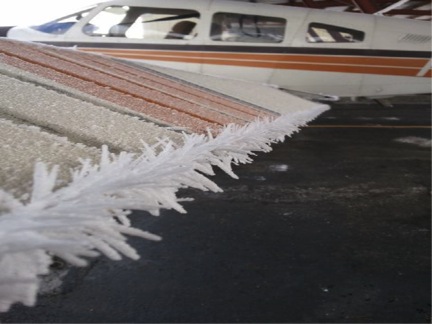 The Polar Vortex has brought winter weather and arctic temperatures to many parts of the country—including areas that rarely see the mercury dip below freezing.
The Polar Vortex has brought winter weather and arctic temperatures to many parts of the country—including areas that rarely see the mercury dip below freezing.
With several more months of winter ahead, clubs may want to review winter operations procedures with members. To get some tips for winter weather flying, we talked to staff and board members of the Ponderosa Aero Club in Boise, Idaho, and reviewed AOPA’s cold weather operations resources online.
“Flying in the wintertime is fantastic. The air is calmer, the sky can be just crystal clear,” Ponderosa General Manager William Foote said. “It’s just spectacular.”
However, aircraft are more cranky and everything takes longer when it gets cold. “The most brutal part of the flight is the preflight and securing the aircraft when you’re done,” William noted.
Ponderosa has a pamphlet with winter operations instructions that members have for their reading and review. It includes instructions for taking off wing covers and cowling covers, engine pre-heat procedures, priming tips, and reminders to clear snow, ice, and frost off the aircraft before flying. Besides taking care of the aircraft, it’s also important to be aware of the ramp, taxiway, and runway conditions. Consider reviewing winter operating procedures at your next Safety Meeting if you haven’t done so already.
Here are some tips to share with your club:
Oil: Winter operations usually call for less viscous oil so it circulates more quickly after engine start. Check your POH or aircraft manual for specific weights.
Tires and Struts: Cold temperatures cause pressure in tires and struts to decrease. If the seal in the oleo strut is deteriorated, the strut will not hold air pressure. The seal must be replaced by a mechanic.
Control Cables: Temperature changes can cause contraction and expansion, so control cables should be adjusted to compensate for those changes. Have an A&P check for proper tension.
Cover or Clear: If your aircraft isn't hangared, make sure the wings and cowling are covered. Ice builds on the wings, resulting in inefficient airflow and longer takeoff runs. If you don't have covers for the wings, use a hand broom to brush off snow and ice. Cover the pitot tube and vents.
Windshield: Do not scrape windshields – they are easy to scratch.
Engine Pre-Heat: A general rule of thumb is anytime the ambient temperature drops below 20 degrees Fahrenheit, the engine should be pre-heated. Check with your club on its procedures.
Warming up: Allow plenty of time for the engine to warm up. Keep it at 1,000 to 1,200 rpm unless it’s necessary to reduce rpm to keep from exceeding the oil pressure redline. As the oil warms up, the rpm can be increased.
Ice: Be aware of icy or slick ramps, taxiways, and runways. Check the brakes before you do your run-up to be sure you can keep the aircraft from moving. Attempting to perform a run-up on ice can result in sliding out of control.
Wind: Hold proper aileron deflection throughout your taxi. This will help prevent the tendency for your aircraft to weathervane into the wind.
Brakes: Brake easy. Planning should include minimum brake usage when landing and when taxiing through snow since warm brakes melt any snow upon stopping. Then the snow refreezes, locking the plane in position.
Cross Wind: A competent pilot will know and adjust his or her cross wind approach to final to the current conditions. A commonly used rule of thumb is cut your max crosswind component in half for a snowy runway, and cut it by 75% for ice landings. This will help prevent the aircraft from weathervaning into the wind.
Ice: There are two different types of ice—rime and clear. Rime icing is characterized by small super cooled water droplets and develops as a thin white cover on leading edges. Clear is, as the name implies, is clear. The super cooled droplets of clear icing are larger and typically found in cumulus clouds. Keep in mind that these two icing types can mix to form what we call “mixed icing.” The bottom line on icing is don’t fly into know icing conditions, even if your aircraft is certified for it.